Plants that Grow in Water: Herbs, Indoor Plants and more Plants
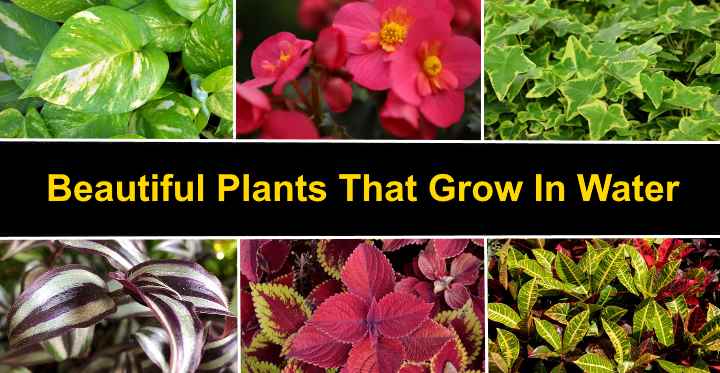
Many indoor houseplants are types of plants that grow well in water. Growing plants in water is ideal if you want an easy way to look after plants indoors. Plants growing without soil requires less maintenance because they are less prone to pests and disease and they don’t need regular watering.
Of course, many plants only grow in water. These indoor water plants are generally suitable for aquariums or indoor water ponds. But this article looks at the best houseplants and other plants that grow well in jars or vases of water.
Growing indoor plants in water without soil is called hydroponic gardening. This water-only gardening method adds nutrition to water rather than relying on soil nutrients. The presence of essential nutrients helps plants live in water for a long time.
However this article is not about hydroponic gardening as done by commercial growers. In commercial hydroponic system the nutrients are delivered in very accurate quantities directly to the root system so the plants get exactly the amount of nutrition to maximize their growth.
Growing Plants in Water
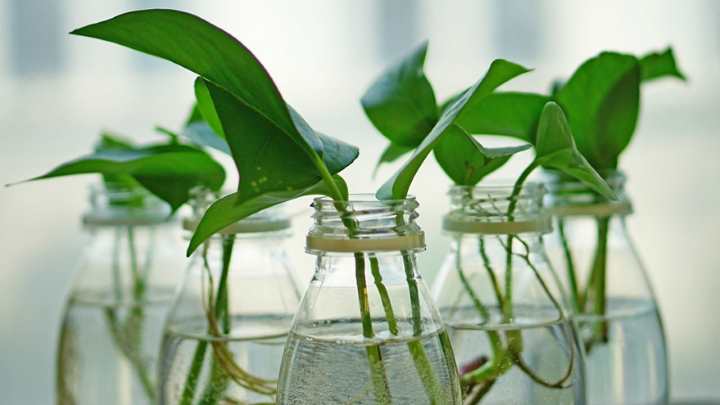
You can propagate stem cuttings in a water bottle or a vase
Growing plants in water usually starts by placing houseplant cuttings in water to root them. Propagating plants in water is an easy way to root plants from the stem cuttings. It’s easy to root plants in jars, bottles, or water vases to grow new houseplants. Soon, you’ll have a tropical indoor water garden. These plants can grow in water for a few weeks or even months.
When your plant cuttings develop roots, you don’t need to transfer them to the soil. You can keep them growing in water vases or jars. In time, the indoor plants will grow new leaves, and they may even start to flower. The beauty is that growing plants this way is a lot less fuss and bother than growing in potting soil.
How to Grow Plants in Water
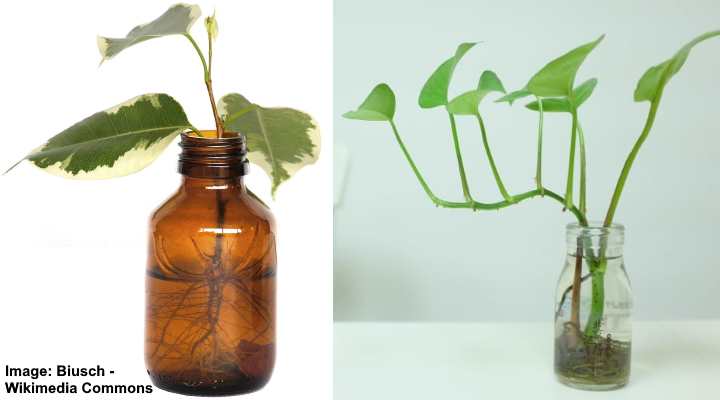
To grow your plant in water add a suitable fertilizer to provide enough nutrients for better growth
To grow plants in water, put a few houseplant cuttings in a jar or vase filled with water. The best type of container for growing plants without soil is a dark or opaque one. This prevents sunlight from causing algae growth. However, any glass jar, bottle, or vase is ideal.
For the best plant growth in a soilless medium, you’ll need more than just water. You can fill the jar three-quarters full with decorative pebbles, sand, colored marbles, or gravel. Mixing some charcoal with the soilless mix helps keep the water clear and fresh.
The next step to growing plants in water is to mix in some water-soluble houseplant fertilizer. This plant “food” provides plenty of nutrients in the water to promote healthy plant growth. This also substitutes for minerals that are usually found in potting soil.
When using the fertilizer to grow plants in water dilute it to one-quarter strength. If you grow a stem cutting, change the water every few days. If you grow an established plant, replace the water and nutrient solution every four to six weeks.
If you want to transfer a potted plant to a soilless environment, remove the plant root ball from the pot. Rinse off all traces of soil from the roots. “Plant” the houseplant in a water environment that has diluted fertilizer. Replace the water with the nutrients every four to six weeks.
The last step is to find some suitable houseplants that grow in water.
Good Plants for Water
Now that you know how to grow plants in water, it’s good to know which plants grow well in water.
Seven excellent plants for growing in water without soil include the following:
- English ivy (Hedera helix)
- Golden pothos (Epipremnum aureum)
- Dumb cane plants (Dieffenbachia)
- Wandering Jew (Tradescantia)
- Flowering begonias
- Lucky Bamboo (Dracaena sanderiana)
- Spider plant (Chlorophytum comosum)
From the list of plants suitable for water growth, hanging or trailing plants are the easiest to root in water. All you need to do is cut a section of the stem just below the node, ensuring that there are at least three or four leaves. Remove the lowest leaf and “plant” in your water environment.
Plants that Grow in Water
Let’s look in more detail at some of the best houseplants for “planting” in water.
Here is a list of plants that grow in water:
Philodendron
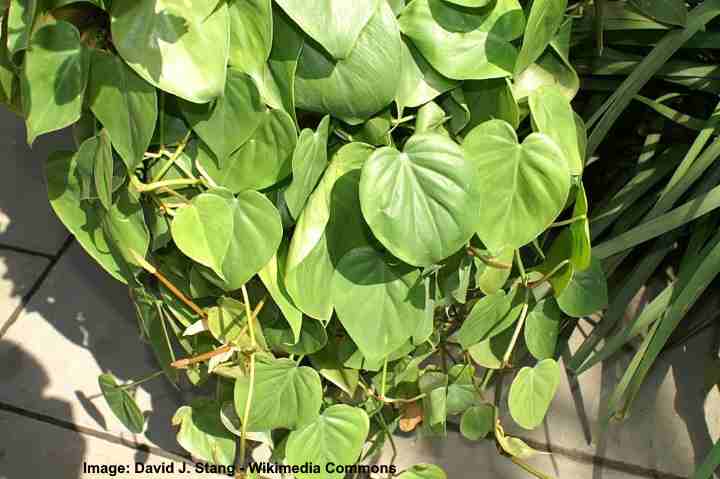
Philodendron hederaceum (Green Heartleaf Philodendron)
Heart-leaf philodendron is an excellent plant for growing in water. This vining plant roots easily in a water vase. Cut a stem about six inches (15 cm) long that has three or four heart-shaped leaves. Put the philodendron cutting in water and place it in a bright location with indirect sunlight.
To promote excellent philodendron growth in water, change the water every four days. Soon roots will start growing. After the plant is established in water, change the water every six weeks, and add the appropriate amount of fertilizer.
Pothos (Epipremnum aureum)
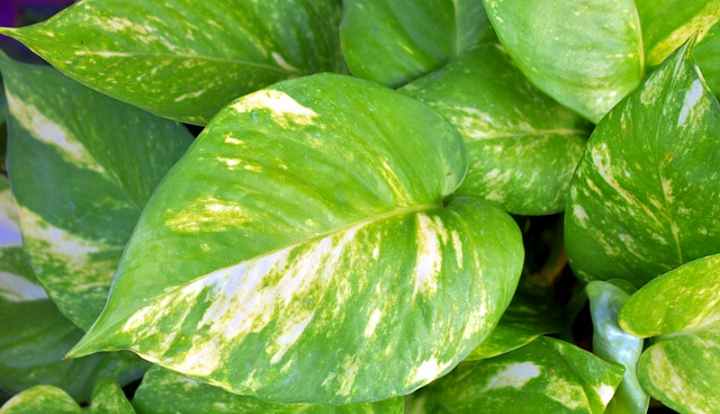
Golden pothos is a common cultivar of pothos plant
Pothos plants are easy to grow in a jar of water. Similar to philodendron, pothos plants have heart-shaped leaves and vining growth. There are many varieties of pothos that look great growing in water. The most stunning pothos water plants are the variegated varieties with golden yellow and green colors.
To grow pothos in water, snip a six-inch length of the stem just below a node. Put in a dark-colored glass bottle or vase and fill with water. Place in partial shade to promote faster growth. Soon, you’ll have beautiful cascading leaves and stems from your water plant.
Chinese Evergreen (Aglaonema)
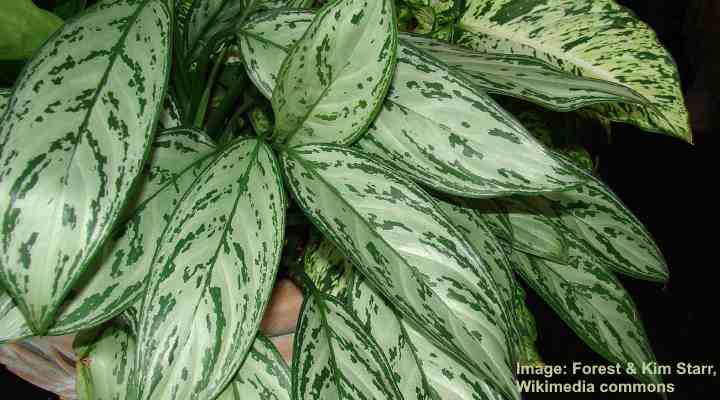
Aglaonema commutatum ‘Silver Queen’ is the most popular cultivar of aglaonema houseplant
Chinese evergreen plants are suited to growing in water because they root easily. What makes Chinese evergreen plants ideal for water growth is their thick central stem. These houseplants are suitable for growing in a bottle or narrow-neck water vase.
Separate a stem from the root ball and remove all the dirt. Put a three-inch layer of decorative items—pebbles, gravel, or sand—in the base of the vase. Fill with water and “plant” your new indoor water plant.
Dumbcane (Dieffenbachia)
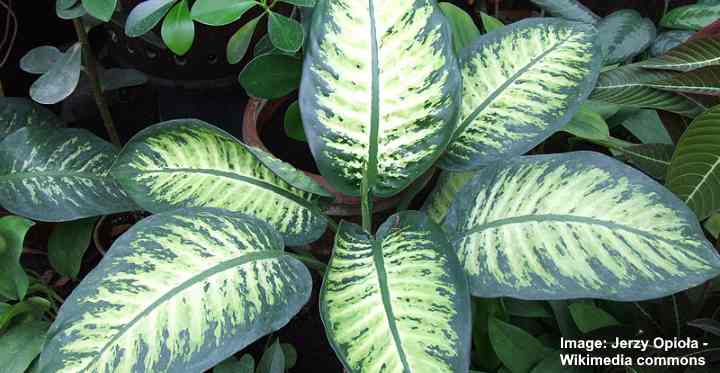
Dieffenbachia seguine has various cultivars highlighting different variegation patterns
Dumbcane plants are an excellent choice of plant for an indoor water garden. Similar to Chinese evergreen plants, the thick stem and large leafy foliage make dumbcanes attractive for growing in vases or water bottles. Use decorative items in the glass container to enhance the appearance of a dumbcane growing in water.
You can continue to grow a dumbcane plant in the water container by changing the water and refreshing nutrients every few weeks. Or, you can transfer to grow a dumbcane plant in a pot.
English Ivy (Hedera helix)

English ivy can also have variegated leaves with creamy and green leaves
One of the easiest trailing plants to root in water is English ivy. You can easily grow English ivy plants in water for a couple of months. After that, you may have to transfer the trailing vine to a soil medium.
However, if you enjoy having English ivy in a water terrarium or indoor water garden, just replace the plant with new cuttings. Keep the water-growing ivy in a bright spot in your room and change the water every so often to prevent algae growth.
Arrowhead (Syngonium podophyllum)
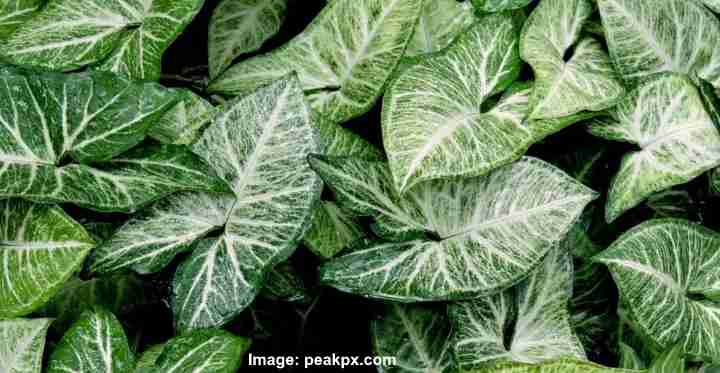
Arrowhead plants are ideal for growing in a water vase. Their large arrow-shaped leaves create a visual impact in any bright room. Cut a section of the stem just below a node that has a few leaves on it. Grow in a large jar filled with water and place in a bright spot.
Arrowhead plants grow best in a warm part of your house with bright indirect light. Growing these plants without soil in jars creates a stunning indoor water garden.
Spider Plant (Chlorophytum comosum)
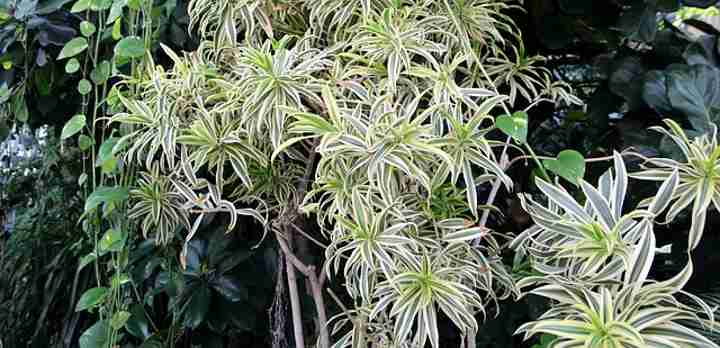
Spider plants grow plantlets that can easily grow in water
Spider plants will grow in water for several weeks. Although spider plants quickly take root in water, they only thrive for a short time. Stems and leaves submerged in water can soon rot. It’s best to use a water garden to propagate spider plants before transferring them to a soil-based growing medium.
Spider plants are excellent houseplants for several reasons. First, they grow plantlets that you can easily root in water. Also, spider plants are on the list of top houseplants to purify indoor air.
Ornamental Sweet Potato (Ipomoea batatas)
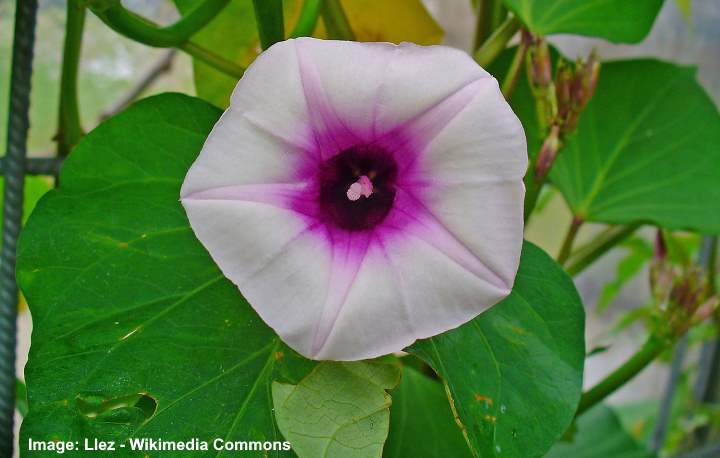
Growing vining sweet potatoes in water is super easy to add a tropical touch to your room. You grow the sweet potato vines in water after sprouting them from a tuber. Once the vines start to grow, snip them off the tuber and grow in water like any other vining plant grown in water.
To start the vine growing, you’ll need an organic edible sweet potato. Fill a jar with water. Support the tuber over the rim of a jar with toothpicks so that one-third of it is in water. Keep the water topped up so that the tuber is always sitting in water. Soon green vining shoots will grow from the top.
Lucky Bamboo (Dracaena sanderiana)

Although lucky bamboo plant looks like bamboo, it is not in the same family as true bamboo
Lucky bamboo is one of the most common water plants. Also called Chinese water bamboo, the water plant will grow in a shallow dish with pebbles and just enough water to cover the roots. Keep the plant growing in a water garden by topping up the water with filtered or unchlorinated water.
The beauty of growing lucky bamboo is that you can shape the cane-like stems. You can grow a single stalk in a narrow water vase or grow a few together to create an exciting feature in an indoor water garden.
Related: The Best Indoor Vine Plants and Climbers
Colorful Plants that Grow in the water
Many plants that live a long time in water also have colorful foliage or beautiful flowers. These plants are suitable for “planting” in water gardens or growing in vases, jars, bottles, or glass containers.
Begonias

Begonias are on the list of unique houseplants due to their unusual foliage
Begonias are some of the most colorful plants to grow in water. There are over 1,800 species of begonias, most of which have colorful foliage. It is easy to root begonias in water by taking a leaf and stem cutting. Many types of wax begonias root well in water and will grow for a few months.
If you’re looking for colorful flowering plants that grow in water, then choose a type of tuberous begonia.
Coleus
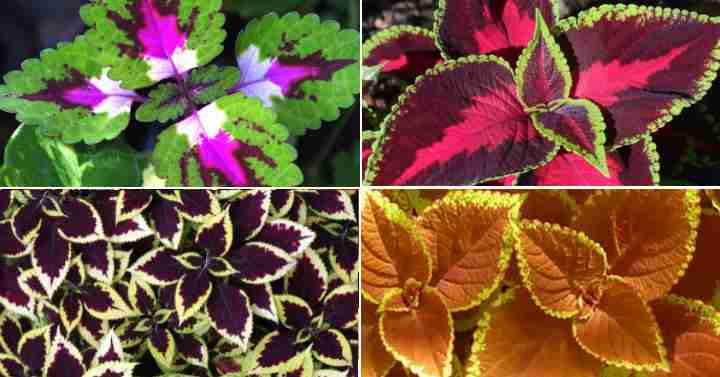
Coleus plants come in a stunning array of colors
Coleus plants have colorful foliage and grow in water for several months. Cut a length of the stem just below a node, making sure there are several of leaves on it. Place the flowering plant in a glass, mason jar, or vase filled with water. Ensure that the leaves are never in the water.
To keep the water plant growing healthy, change the water monthly, and add some compost tea for fertilizer.
Wandering Jew (Tradescantia)
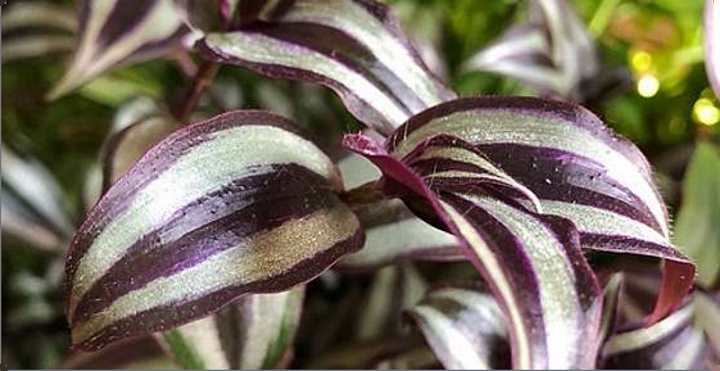
Tradescantia zebrina has purple and green-silvery leaves with a stripe pattern that resembles zebra’s stripes
Wandering Jew plants have attractive foliage and grow well in water. These Tradescantia species root super fast in water and will continue to grow in a water garden for many months. You can create colorful cascading foliage by “planting” many Wandering Jew plants in a large jar.
To create a stunning, colorful focal point, choose a type of purple Tradescantia or striped Wandering Jew. You can continue to grow this trailing hanging plant in water, or you can transfer to a hanging basket.
Variegated Croton (Codiaeum variegatum)

Variegated croton has many cultivars with various foliage colors and patterns
Plant variegated croton in water if you want a plant with super-bright foliage. The bright variegated leaves will brighten up any room. The long straight stem with colorful oval leaves is ideal for growing in a bottle of water or narrow vase.
Croton plants won’t grow forever in water. But they will flourish for several weeks while the roots develop in water.
Peace Lilies (Spathiphyllum)

Peace lilies are one of the top flowering plants that clean the air, thrive in low light, and don’t need a lot of care
Peace lilies grow well in water and produce spectacular flowers. Peace lilies are excellent low-maintenance flowering plants if you want to add color to a water terrarium. The large lush green leaves and white spathe flowers will create an attractive centerpiece on a table or windowsill.
To grow peace lilies in water, remove the plant from the soil and wash off all dirt. Place the stems in a vase of water, ensuring that the leaves aren’t in the water. Change the water weekly and add a touch of fertilizer if necessary.
Paperwhite (Narcissus papyraceus)

Paperwhite is one of the best flowering plants for a glass terrarium. Using pebbles, shells, and other decorative objects, it creates an attractive indoor water garden. Plant the paperwhite bulbs in the soilless mix and fill just enough water so that it covers the roots but not touching the bulbs.
The long tube-like stems will create an attractive visual piece as they stretch up from the terrarium.
To force paperwhite narcissus bloom indoors place it in a cool place until it starts to develop roots. When you see the roots, move it to a sunny location. About three to four weeks after planting your water garden, the paperwhite narcissus plants should flower.
Moses-in-a-Basket (Tradescantia spathacea)
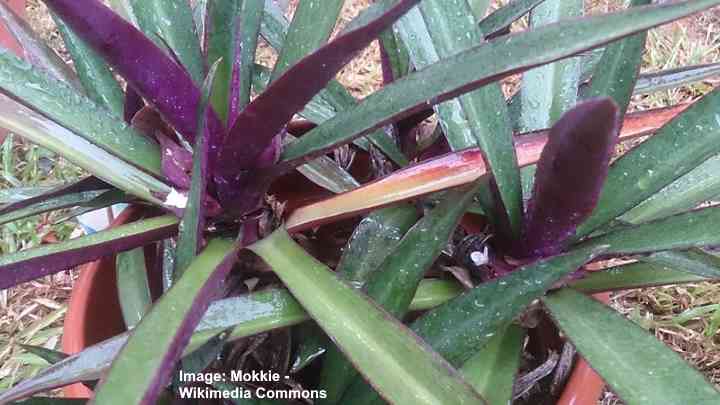
Another easy flowering plant to grow in water is Moses-in-a-basket plant. This species of Tradescantia grows pretty little white flowers. The long, spiky, waxy foliage looks spectacular as it seems to explode out the top of a water vase or mason jar.
Moses-in-a-basket (also called Moses-in-the-cradle) is a plant that is easy to care for. Take a few stem cuttings at least six inches (15 cm) long and put in a jar or vase of water. Replace the water and fertilizer mixture every week or so to keep the plant’s water fresh.
Impatiens
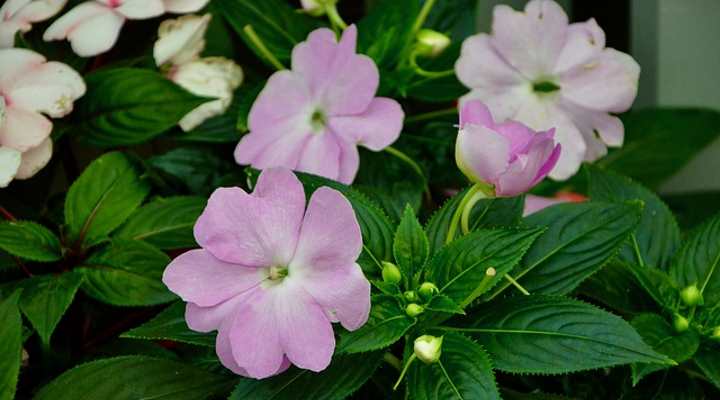
Impatiens include variety of flowers with different shapes and colors
Impatiens is a beautiful flowering plant that grows in water for a long time. Cut a piece of stem from a healthy plant just below the node. Place in a vase of water, making sure there are no leaves in the water. Keep for a few months in a water environment, changing the water and fertilizing regularly.
Impatiens plants love soggy damp soil and also grow well as a marginal pond plant.
Flowering Plants that Grow in Water Indoors
Growing flowering plants in water is a great way to create an attractive floral display in your room. Flower plant cuttings that grow in water usually last longer than cut flowers. Putting the stems in water is also easy way to propagate the plants.
Here are some excellent flowering plants that are suitable to grow in water:
- Begonias—A flowering water plant that is easy to grow indoors. Begonias produce beautiful showy flowers, as well as stunning leaf foliage.
- Paperwhite—These bulbous flowering plants are ideal for terrariums or growing in decorative glass jars. Clusters of dainty white flowers crown long tubular stems.
- Peace lilies—Air-filtering plants that have bright white spathe flowers.
- Impatiens – Impatiens include more than 1,000 species of flowering plants with many species tolerating filtered light and full shade.
Related: The Best Plants for Hanging Baskets (Flowers and Other Plants)
Vegetables to Grow in Water (Food Plants that Grow in Water)
You can also grow some vegetables in water for their greenery. Some types of vegetables suitable for growing in water include some edible root plants or bulbous vegetables.
Here are a few food plants you can grow in water:
- Carrot tops—Cut about 1” (2.5 cm) from the top of a few carrots. Put in a shallow dish and put in enough water, so it’s just touching the rim of the stump. Add a little water regularly to top up the water. Soon, you’ll have green tops sprouting from your carrots.
- Onion greens—With toothpicks, support an onion on the rim of a glass. Fill the glass with water, so it’s just touching the base of the onion. Top up the water level to make sure the bottom of the onion is covered. You should get edible onion greens.
- Celery – Cut off about 2 inches (5 cm) of the celery root end. Place in a shallow water jar so half of the cutting is submerged. Place in a sunny location. After several days you will see small leaves coming out of the center of the base.
Herbs that Grow in Water
Some herbs are easy to grow in water. All you need to do is submerge the stems in water, making sure there are no leaves in the water.
Some of the easiest herbs to grow in water include the following:
- Sage
- Mint
- Basil
- Oregano
- Lemon balm
- Stevia
Related articles:
- The Best Indoor Hanging Plants
- How Often to Water Houseplants
- The Best Water Plants: Aquatic Plants for Ponds
